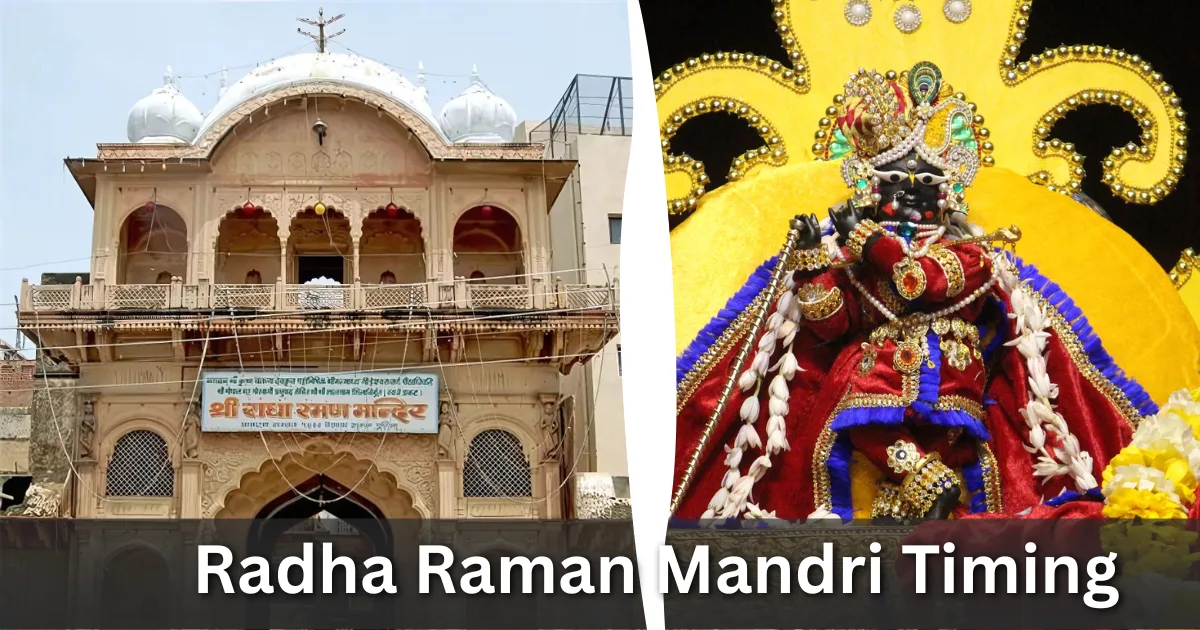Radha Raman Mandir is not just a temple; it is a living embodiment of devotion where the Lord is believed to reside in his most active form. Situated in the holy town of Vrindavan, this temple draws thousands of devotees, historians, and spiritual seekers every year. Understanding the Radha Raman Mandir timing is essential to truly experience its divine charm, participate in its soulful aartis, and witness its intricate daily rituals.
History of Radha Raman Mandir
Radha Raman Temple was established in 1542 by Gopala Bhatta Goswami, one of the six prominent Goswamis of Vrindavan who were direct disciples of Sri Chaitanya Mahaprabhu. The temple houses a self-manifested deity of Lord Krishna in the form of Radha Raman, which miraculously appeared from a salagram shila (sacred stone) without human carving. Unlike other temples, Radha Raman is rever for having a deity that contains both Radha and Krishna in one form.
Radha Raman Mandir Timing
Summer Timings (April – October)
- Morning Darshan: 8:00 AM – 12:30 PM
- Evening Darshan: 4:30 PM – 8:30 PM
Arti Timing
- Mangla Aarti: 5:00 AM
- Shringar Aarti: 10:00 AM
- Rajbhog Aarti: 12:30 PM
- Sandhya Aarti: 7:15 PM
- Shayan Aarti: 9:30 PM
- Samaj Gayan: 7:30 PM
Winter Timings (November – March):
- Morning Darshan: 8:30 AM – 12:30 PM
- Evening Darshan: 5:30 PM – 7:30 PM
Arti Timing
- Mangla Aarti: 5:30 AM
- Shringar Aarti: 10:30 AM
- Rajbhog Aarti: 12:30 PM
- Sandhya Aarti: 6:30 PM
- Shayan Aarti: 9:00 PM
Note: On festival days like Janmashtami and Radhashtami, darshan hours may vary. Devotees are advised to arrive early.
Spiritual Significance of Radha Raman Mandir
Radha Raman Mandir is unique because it contain no separate idol of Radharani, yet devote believe that Radha reside eternally in the heart of Lord Radha Raman. The temple is renowned for maintaining a pure Vaishnava tradition, with rituals performed exactly as prescribed by the scriptures for over 480 years. It is a center of devotion, austerity, and spiritual awakening.
Daily Rituals and Aartis
- Mangla Aarti: Performed in the early morning with soft chants and lamp offerings.
- Shringar and Bhog Aarti: The deity is adorned with jewels and offered freshly prepared satvik meals.
- Sandhya Aarti: As the sun set, the temple glows with dozens of lamps during this mesmerizing ceremony.
- Shayan Aarti: The final prayer of the day before the Lord rest.
Festivals Celebrated at Radha Raman Temple
- Janmashtami – Celebrated with grand Abhishekams and midnight darshan.
- Radhashtami – Devotees gather for special kirtans and bhogs.
- Chandan Yatra – During summer, the deity is adorned with sandalwood paste.
- Holika Dahan & Holi – The temple becomes the center of Braj’s famous color festivities.
- Kartika Month – Lighting of lamps and devotional singing every evening.
Nearby Places to Visit
- Nidhivan – Known for its mysterious nightly Raas Leela.
- Seva Kunj – A sacred garden associated with Krishna and Radha’s divine play.
- Banke Bihari Temple – Just a few minutes away and one of the most popular temples.
- Prem Mandir – A modern architectural marvel, especially stunning at night.
- ISKCON Vrindavan – A major attraction for international devotees.
Best Time to Visit Radha Raman Mandir
The ideal time to visit is during the cooler months (October to March), when the temple host many vibrant festivals and weather condition are pleasant. Avoid peak summer (May–June) unles attending Chandan Yatra.
How to Reach Radha Raman Mandir
- From Mathura Junction: 12 km by auto or e-rickshaw
- From Delhi: ~180 km via Yamuna Expressway
- By Train: Reach Mathura, then local transport to Vrindavan
- By Road: Easily accessible via buses and taxis from Agra, Noida, and Delhi
Tips for First-Time Visitors
- Maintain silence and modesty inside temple premises.
- Photography is usually prohibited inside the sanctum.
- Wear traditional or decent attire.
- Arrive early during festivals to avoid crowd.
- Use local guide only if authorized.
Conclusion
Radha Raman Mandir is not merely a place of worship but an eternal flame of devotion burning in the heart of Vrindavan. With its strict tradition, divine rituals, and serene ambiance, it offers an unmatched spiritual experience. Knowing the Radha Raman Mandir timing helps you plan your visit meaningfully. Mathura Vrindavan City warmly welcomes you to explore this temple and the spiritual heart of Braj. Book with us to experience the divine up close.
FAQs Radha Raman Mandir Timing
1. What is the darshan timing of Radha Raman Temple in Vrindavan?
Morning darshan is from 8:00 AM – 12:30 PM in summer and 8:30 AM – 12:30 PM in winter. Evening darshan varies accordingly.
2. When is Mangla Aarti performed at Radha Raman Temple?
In summer, it’s at 4:00 AM. In winter, it begins at 5:30 AM.
3. Is there an idol of Radha in the temple?
No, but Radha is believe to be present eternally within Lord Radha Raman form.
4. Who established the Radha Raman Temple?
It was founded by Gopala Bhatta Goswami in the 16th century.
5. What is unique about the deity of Radha Raman?
The deity is self-manifest from a salagram shila and is not man-made.
6. What should I wear when visiting the temple?
Modest, preferably traditional Indian attire is recommend.
7. Are mobile phones and photography allowed?
Phones should be kept on silent; photography is generally restrict.
8. Which month is best for visiting the temple?
October to March is ideal due to pleasant weather and festival.
9. Is there any entry fee for the temple?
No, entry is completely free.
10. Can I attend the aartis as a visitor?
Yes, all devote are welcome to attend, though it’s best to arrive early.
